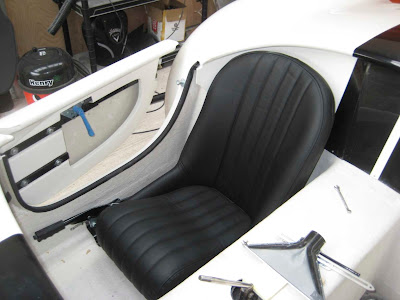I wanted ot do this when I was feeling fresh and not after a long day in the office and I wanted to make sure I had plenty of time in case things didn't go according to plan.
Opinions and techniques for fitting the roll hoops vary form the plumb line method as used by the factory to a steel rod and template set up as I believe created by Steve R. Time taken by other builders to fit them also seems to vary greatly and I must admit to being somewhat nervous about starting this task.
Before starting, I had a good chat with Alan GD who explained how to set the car up level and then how to use the plumb line method. I had already sourced some 12mm threaded bar and some plywood to make template but after listening to his advice and discussing/arguing with my co-builder Ali I decided to go with the factory method.
With a method agreed, I started to look at how to physically implement the plan and it became clear I was going to need a new drill or at least a 90 deg angle chuck for my existing drill as its too big to get in the confined spaces inside the boot. I managed to find a suitable attachment in stock locally at Screw Fix but this wasted a whole lot of time and it was nearly lunchtime by the time I actually got started.
However, after a full afternoon I had got both roll bars trail fitted. Admittedly, they still need to be filled with expanding foam (apparently this helps reduce road noise from being transmitted up from the chassis), bolted up in place and then the holes in the scuttle tidying up and rubber gaiters fitting but the bulk of this daunting task is behind me.
The following summarises the method I used.
1. The car was jacked up until it was level both front to back and left to right.
2. The rear wheels were removed for access
3. The rear coil spring retaining bolt was removed so that I could get access to mark the position of the outer leg mounting hole
4. Having marked through the holes in the mounting brakets for the front two legs small pilot holes were drilled through from under the boot. The same was then done for the rear leg (although this position is flexible to a degree as the bracket can swivel left or right a little.
5. I then used a hole saw of similar diameter to the legs to open up the lower pilot holes. This gives a clear view of the mounting holes.
6. A plumb line was then taken from the centre of the mounting hole and the position marked on the underside of the rear scuttle. This is a little tricky but lying in the boot helps!!
7. Pilot holes were then drilled into the top scuttle from the underside. These holes were then checked for accuracy by running the plumb line all the way through the hole. A couple were a little bit out so were re-drilled. Then the holes were opened up with a hole saw and dremel.
8. The roll hoops were then passed through and positions checked by running the fixing bolts into place.
After all that it was time for a cold beer...
Next time I will tidy up the holes, fill with foam and fit the rubber gaiters. Need to read up on what people do for sealing the lower holes and then look at getting the carpet in as the roll hoops pass through the carpet in the boot and they cant be bolted in place until this is done.




















































